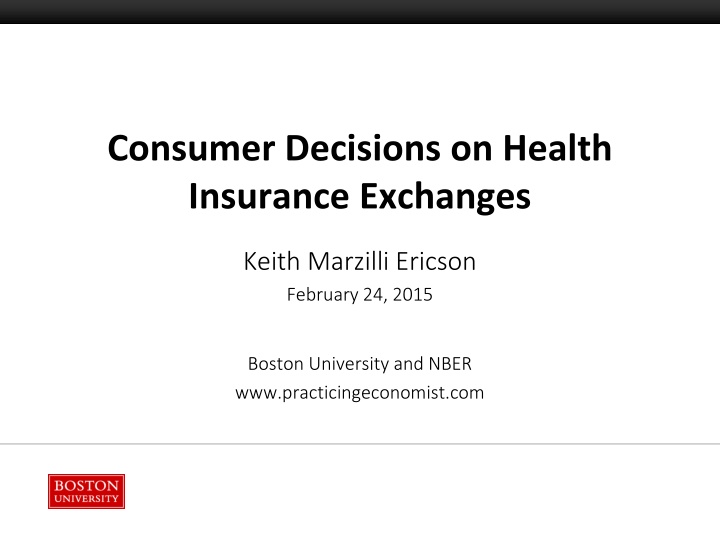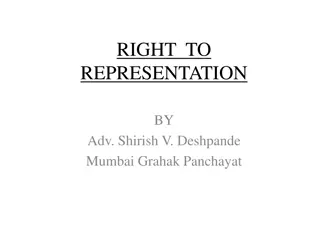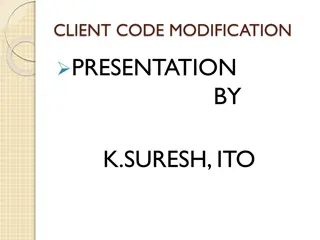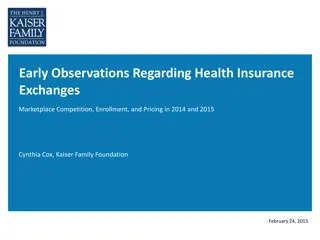Insights on Consumer Decisions in Health Insurance Exchanges
This content explores consumer decisions on health insurance exchanges, focusing on price sensitivity, plan generosity, age variations, and implications for insurers and consumers. It discusses factors influencing consumer choices, such as age, plan pricing structures, and the impact of standardization. Research findings highlight the importance of pricing strategies, plan comparison tools, and the need for regulatory adjustments to ensure fair pricing and coverage options for all age groups.
Download Presentation

Please find below an Image/Link to download the presentation.
The content on the website is provided AS IS for your information and personal use only. It may not be sold, licensed, or shared on other websites without obtaining consent from the author.If you encounter any issues during the download, it is possible that the publisher has removed the file from their server.
You are allowed to download the files provided on this website for personal or commercial use, subject to the condition that they are used lawfully. All files are the property of their respective owners.
The content on the website is provided AS IS for your information and personal use only. It may not be sold, licensed, or shared on other websites without obtaining consent from the author.
E N D
Presentation Transcript
Consumer Decisions on Health Insurance Exchanges Keith Marzilli Ericson February 24, 2015 Boston University and NBER www.practicingeconomist.com
Consumer Decisions on HIX Price Sensitivity: Varies by Age Standardization and Plan Generosity Valuing (and Observing?) Networks Renewal Decisions and Defaults
Learning from Pre-ACA HIX Medicare Part D Massachusetts HIX Rx drug insurance for elderly, 2006+ Guaranteed issue, community rating Risk adjustment, subsidies Result of state reform Guaranteed issue, modified community rating 2007-2013: no risk adjustment, no subsidies (separate subsidized plans)
Consumer Price Sensitivity on Mass. HIX How do consumers substitute among plans when insurers raise premiums? Determines how insurers set price markups Result: big gain to being the cheapest plan Equivalent to $300-$550/year premium decrease Consistent with heuristic choose the cheapest ; cheapest plan is listed first Competition at bottom of the market may be quite different from top of the market Ericson and Starc. 2012. "Heuristics and Heterogeneity in Health Insurance Exchanges . American Economic Review
Consumer Price Sensitivity on Mass. HIX Over/under age 45: older half as price sensitive because sicker, richer, or relationship w/doctor Result: insurers want higher markups for older Limiting age-based pricing links prices of old/young Leads to transfers from young to old Also lowers insurers profits by $300 pp/year Why? Insurers price to marginal consumer, who is young and inexpensive Raises consumer surplus by $600 pp/year Ericson and Starc. Forthcoming. "Pricing Regulation and Imperfect Competition . Review of Economics and Statistics
Standardization and Plan Generosity Arranging plans in tiers helps consumer compare Non-neutral names: gold is a recommendation Hard to compare within tier Is a $250 increase in deductible worth a 5% decrease in coinsurance? Massachusetts, 2010: Standardized cost sharing parameters within tier Ericson and Starc. 2013. "How Product Standardization Affects Choice . NBER WP.
Result of Standardization More generous plans chosen. Tier became more important in decisions Little change in price sensitivity Major shift in brand choices Made consumers better off
Networks How do consumers value provider coverage network? Hard to observe network (many doctors, hospitals) No direct choice evidence until now Massachusetts HIX 2009-2010 Had useful search tool Measure network breadth by % of all hospital admissions statewide that would be covered by insurer Measure willingness to pay from plan choices
Networks Consumers willing to pay for broader network It varies by age $750/year for 30 year olds, $1500/year for 60 year olds Hard to distinguish different networks within brand Don t know much about contexts with opaque network info Or unfamiliar brands Blue Cross 0 Harvard Annual WTP ($) Relative to Blue Cross Neighborhood Fallon Direct -500 Fallon Select Tufts (Select) -1000 .4 .6 .8 1 % of Hospital Admission Events Covered Ericson and Starc. Forthcoming. "Measuring Consumer Valuation of Limited Provider Networks . American Econ. Rev.
Inertia in Plan Choice: Defaults Matter Medicare Part D Initial assignment default: Low Income Subsidy (LIS) recipients assigned to plan below threshold Matters in year 1 and beyond Automatic switching default If firm raises price in year 2, LIS switched to cheaper plan High income enrollees have to actively switch Ericson. 2014. "Consumer Inertia and Firm Pricing in Medicare Part D . AEJ Policy.
Inertia in Plan Choice: Defaults Matter Medicare Part D Premiums in 2010 Medicare Part D Premiums in 2010 .08 .08 Insurers respond by using invest-then- harvest pricing Offer low prices in early years, capture enrollees Costly to switch Raise prices in later years Result: unnecessary churn between plans, lower investment in enrollee health .06 .06 Density Density .04 .04 .02 .02 0 0 0 0 20 20 40 40 60 60 80 80 Monthly Premium Monthly Premium 2006-7 Cohorts 2008+ Cohorts 2008+ Cohorts Result: Older plans are 20% more expensive than equivalent newly introduced plans (weighted by enrollment) Ericson. 2014. "Consumer Inertia and Firm Pricing in Medicare Part D . AEJ Policy.
Consumer Decision Consumer Decision- -Making on HIX Making on HIX HIXs: more choice but difficult choices HIX design can help consumers Defaults Recommendations Standardization for comparison Employers played this role in employer-sponsored insurance More work: consumers and provider networks, including disclosure of network info























